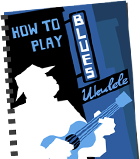I’m a sucker for a new gadget. The more useless and ridiculous the better (e.g. I’ve spent the last year trying to not buy an Apple Watch). So I couldn’t resist picking up the most ridiculous bit of ukulele kit: a spider capo.
What the Hell is a Spider Capo?
A standard capo frets all the strings on the fret you put it on. But a spider capo lets you choose which strings it frets and which are left open.
For example, in this photo I have the capo on the second fret with the levers on the g-, C- and E-strings down and the A-string left open. That means when you play all the strings you get a D chord.
They claim you get “hundreds of open string tunings”. But if you want to be picky – and I certainly do – I make it 15 possible combinations per fret (2^4 total combinations less one for none of the strings capoed). Being generous and saying it can fit on 12 frets that’s 180 combinations (181 if you count gCEA).
Why not just use an open tuning? The biggest reason is that all the chord shapes and scale patterns you know still work when you use a spider capo. E.g. if you tuned the ukulele to an open D chord an A chord is 0234 and C is 3213. But with a spider capo set up to a D chord an A chord is just the G shape (0232) and C is a Bb shape (3211).
The spider capo is also more adaptable than using open tunings. In the second piece in the video above I have the g- and A-strings fretted at the fifth fret. Making them higher than is practical through retuning.
The Good Stuff
Highly Adjustable: You can adjust the width of the entire spider capo and the distance between the levers a great deal. It’s fits on all my ukes from soprano to baritone without any problem.
Creates Unique Patterns: I had a lot of fun messing around and came up with things I wouldn’t have been able to play any other way. And it’s a fun trick to play below the capo as well as above it.
Quick Lever Switching: Flicking a lever on or off the string is lightening quick. Quick enough you could switch levers mid-song if the situation called for it.
Well Made: It feels like a sturdy and durable piece of kit.
The Not So Good Stuff
Fiddly to Attach: It’s certainly not like a standard capo that you can slap on in two seconds. Even once you have all the levers properly aligned for your uke it takes time to get it fixed properly. It’s a lot easier to attach the capo wonky than to attach it correctly. You have to be careful that the little ridges under the capo rest on the fretboard rather than on the frets or dangling in mid air. And they really seem to repel the fretboard at every opportunity. Trying to make it flush against the fret often means that the ridges at the back of the capo are over the fret behind it.
Holding Thin Strings: I found that quite often it would produce buzzes or mute high-g and A-strings. The levers are concave where they touch the strings and the middle isn’t low enough to fret properly. So you have to position the string on one side of the lever.
Here’s a video with the capo attached as well as I can get it but with the string in the middle of the lever:
Not All That Useful: I had fun playing around with with it but I’ve not thought, “A spider capo would be useful to play this.” I haven’t found much practical, day-to-day use for it.
Overall
I can’t recommend getting a spider capo mini to most ukers. There are few situations where they’d come in handy.
The only type of player I’d even reservedly recommend a spider capo for are people who like writing their own tunes and has plenty of time to spend attaching it. If you use one I’m sure it’d inspire a few tunes you wouldn’t have otherwise come up with.





I also use a spider capo. Here sample.
Capo 0222 https://youtu.be/CMSl5I_vYFA
But I’d rather use a “partial capo”. Better is fixed.
(Capo 0222) https://youtu.be/RoighH5-sAU
(Capo 5550) https://youtu.be/TOr6OE2NweQ